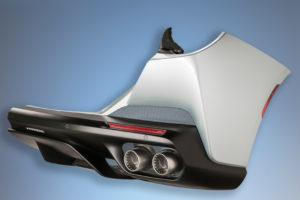
BASF: Joint Elastolit project with STR Automotive can lightweight bumper walls below 3 mm
By onAnnouncements | Market Trends | Repair Operations | Technology
BASF on Wednesday announced it and STR Automotive had succeeded in lowering the weight of short-fiber reinforced polyurethane parts like bumpers with BASF’s new Elastolit R 8819 Lightweight material.
“The usual component thickness of 3.0 mm can be reduced to less than 2.5 mm, without detrimental effects on processing, quality or mechanical properties,” BASF wrote in a news release.
BASF described the application as relevant to “premium vehicles” and “small car series.” However, as technology has a way of growing cheaper over time, mass-market collision repairers will want to keep an eye on the product.
BASF said bumpers of those vehicles are typically 3 mm, and researchers have been unable to shave weight without other qualities suffering.
“Attempts to lower the weight by reducing the component thickness or using a special filler combination and an associated lower material density failed due to insufficient mechanical properties such as mechanical strength, stiffness and impact strength,” BASF wrote.
The Elastolit R 8819 solved the problem with a high-modulus polymer resin that offered “with high temperature resistance, stiffness and very good impact strength.” (STR Automotive even sees the material’s temperature stability as offering enough potential for applications like the engine compartment, according to BASF.)
“The improved performance of the matrix material allows the designer to create a noticeably thinner component, without having to accept limitations in quality,” Jürgen Schneider of BASF Polyurethanes technical development said in a statement.
BASF said an OEM or supplier could reinforce the polymer with a variety of substances for different vehicle exterior applications, including “a mineral standard fiber for components like rear bumpers, a mineral/carbon fiber combination for vertical components with low thermal expansion coefficient (e.g. side panel) or a combination of carbon fibers and light hollow glass spheres for components for which a particularly high weight reduction is a priority.”
Learn more about vehicle technology and trends at Repairer Driven Education
Find out more at SEMA about vehicle technology and trends with “Repair process 2020” featuring Doug Craig of LORD; “Mobility: The Future of Automotive Protection and Beautification” with Jennifer Boros, Gareth Hughes and Ranju Arya of PPG; “Auto industry disruption: Win despite change!” with Frank Terlep of asTech; and “Unraveling the Mystery of Structural Bonding Adhesives” with Shawn Collins of 3M. The sessions are part of the Society of Collision Repair Specialists Repairer Driven Education Series running Nov. 4-8. Register here for individual courses or the series pass package deal, which includes the entire week of classes, all three parts of the OEM Summit, IDEAS Collide and the Nov. 7 Sky Villa afterparty.
Performance materials-transportation spokesman Max Kron confirmed in an email Friday that the Elastolit substrates could be refinished by a body shop. However, he said they would not be repairable.
“Elastolit is a PU-RRIM short-fiber reinforced, compact and tough thermosetting (2-component reactive) material,” he explained.
BASF said the first serial components made out of the new Elastolit cut more than 1.32 pounds per square meter of surface area, which the company said meant nearly 3.1 pounds per rear panel.
“With the new material and the compatible filler options, we have a good set of tools enabling us to satisfy different requirements,” STR CEO Massimo Cecchini said in a statement. “For our customers it is important that they get high-quality components. Weight reduction must not be at the expense of quality and there must be balanced price-performance ratio.”
BASF performance materials key account manager Giuseppe Monaco credited STR for getting the breakthrough on the market.
“With this innovative specialist, we have a partner who supports material development at an early stage in existing components and has brought his expertise from component construction and manufacturing,” he said in a statement.
More information:
BASF, Sept. 18, 2019
BASF said it in conjunction with STR Automotive was able to get bumper fascias below 3 mm without sacrificing quality. (Provided by BASF)

